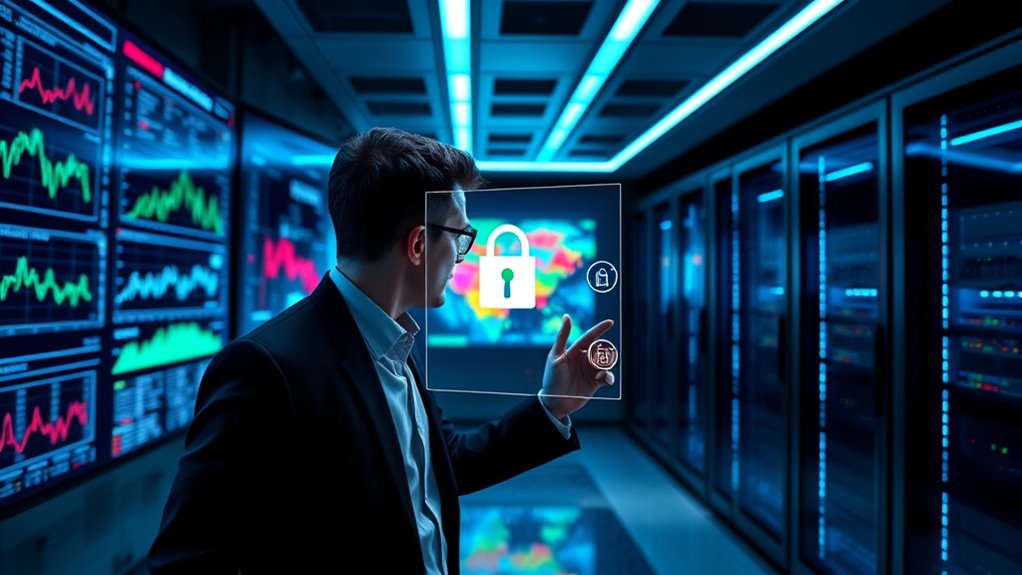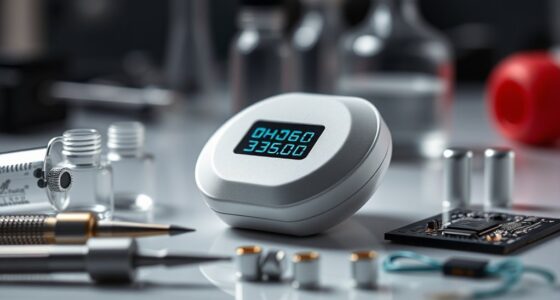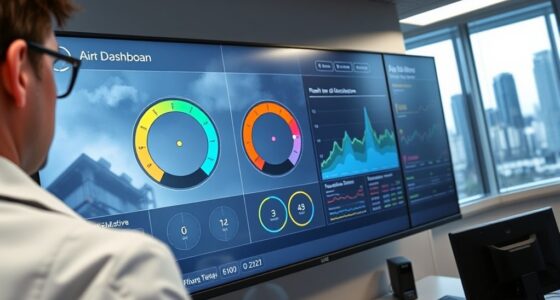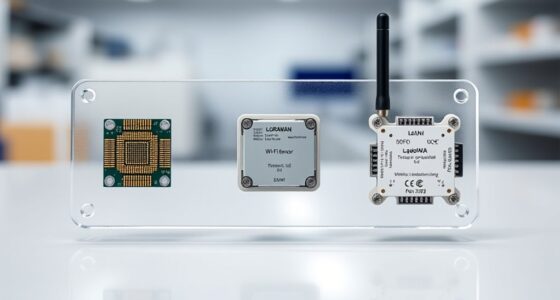To manage your personal and building sensor data privacy, focus on applying layered strategies like anonymization and strict access controls. Anonymize data to hide identities and locations, making it harder for hackers to trace back to individuals. Implement strong authentication to limit access only to authorized users. Combining these measures helps protect sensitive information from misuse or breaches. Keep exploring these techniques further to better understand how to secure your data effectively and stay protected.
Key Takeaways
- Implement data anonymization techniques to disguise personal identifiers and location details before sharing sensor data.
- Enforce strict access control measures using authentication and permissions to limit data access to authorized users.
- Utilize AI-driven security tools for real-time threat detection and response to protect sensor data integrity.
- Employ layered privacy strategies combining anonymization and access control for comprehensive data protection.
- Regularly review and update privacy protocols to adapt to evolving security threats and maintain data confidentiality.

Have you ever wondered how your device collects and uses your sensor data? When you interact with smart devices, apps, or even building management systems, your sensor data is constantly being gathered to improve functionality, security, or user experience. But with this collection comes the vital responsibility of ensuring your personal information stays private and protected. Two key strategies to achieve this are data anonymization and access control. Data anonymization involves removing or disguising identifying details from your sensor data, making it difficult for anyone to trace information back to you. For example, instead of storing exact locations or personal identifiers, systems can replace these with generic tags or pseudonyms. This way, even if someone gains access to the data, they can’t link it directly to you, considerably reducing the risk of privacy breaches. Implementing robust data anonymization techniques is essential, especially when sharing data for research, analytics, or third-party services, because it balances the benefits of data use with your right to privacy. On the other hand, access control is about limiting who can see, modify, or use your sensor data. It’s like setting up a digital gatekeeper—only authorized individuals or systems can access sensitive information. Effective access control relies on authentication methods such as passwords, biometric verification, or digital certificates to ensure that only trusted users can view or handle your data. It also involves defining permissions—what each user can do with the data—to prevent unauthorized modifications or leaks. For instance, a building’s security system might allow maintenance staff to view security footage but restrict access to sensitive personal information. Proper access controls not only protect your data from malicious attacks but also prevent accidental leaks caused by misconfigured permissions. Additionally, advancements in AI technology are being used to detect and respond to potential security threats in real time, further enhancing data protection. Combining data anonymization with access control creates a layered defense. While anonymization reduces the risk if data is intercepted or mishandled, access control ensures that only the right people can even reach the data in the first place. This dual approach helps you maintain control over your sensor data, whether it’s generated by your personal devices or collected by building management systems. It’s important to periodically review and update these protections to account for new security threats or changes in data usage. Ultimately, understanding how these measures work empowers you to make informed decisions about your data privacy. You can advocate for stronger privacy practices, request clearer data handling policies, or choose devices and services that prioritize your security. Protecting your sensor data isn’t just about complying with regulations; it’s about safeguarding your personal space and maintaining trust in the digital systems you rely on daily.
Frequently Asked Questions
How Can Individuals Verify Sensor Data Privacy Policies?
To verify sensor data privacy policies, you should first carefully read the privacy policies provided by the organization. Look for clear information on how your data is collected, used, and shared. Guarantee that there’s a straightforward way to give or withdraw user consent. If anything is unclear, don’t hesitate to ask questions or seek out additional details to protect your personal information and understand how your data is managed.
What Are the Legal Implications of Sensor Data Breaches?
A data breach is like a ticking time bomb, and you need to be prepared. If sensor data is compromised, you face serious legal implications, including penalties for non-compliance and breach liabilities. You must guarantee legal compliance to avoid fines and reputational damage. Protecting personal and building data isn’t just good practice — it’s a legal obligation that can protect you from costly lawsuits and regulatory sanctions.
How Does Anonymization Affect Sensor Data Utility?
Anonymization, like data masking, reduces the utility of sensor data because it hides identifiable details, making analysis less precise. You’ll face utility trade-offs: stronger privacy measures protect personal info but may limit insights. By applying data masking, you diminish re-identification risks, yet the data’s usefulness for accurate decision-making decreases. Balancing privacy with data utility requires careful consideration of these utility trade-offs to make certain meaningful insights without compromising privacy.
Which Industries Are Most Vulnerable to Sensor Data Privacy Issues?
You’re most vulnerable to sensor data privacy issues in industries like healthcare, manufacturing, and finance. These sectors face risks from industrial espionage and disputes over data ownership, making sensitive personal and business information targets. Protecting data involves strict access controls, encryption, and clear policies. Staying aware of vulnerabilities helps you prevent breaches, safeguard customer trust, and ensure compliance with privacy regulations.
What Emerging Technologies Enhance Sensor Data Privacy?
You can enhance sensor data privacy by adopting emerging technologies like advanced encryption techniques and prioritizing user consent. Encryption protects data during transmission and storage, ensuring unauthorized access is thwarted. Meanwhile, transparent user consent empowers individuals to control their data, fostering trust. Together, these technologies create a secure environment where privacy is respected and data remains protected, giving you peace of mind in an increasingly connected world.
Conclusion
To protect personal and building data, prioritize privacy with proactive policies and persistent precautions. By understanding the importance of data defense, you can decisively diminish dangers and defend your digital domain. Remember, vigilance and vigilance alone will vault your values from vulnerability. Stay savvy, stay secure—secure your sensor data today to safeguard your space and self. Your privacy depends on your proactive pursuit of protection—powerful, prudent, and prepared.










